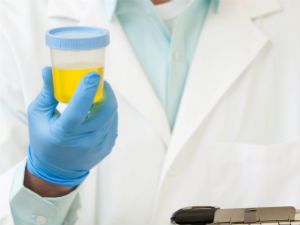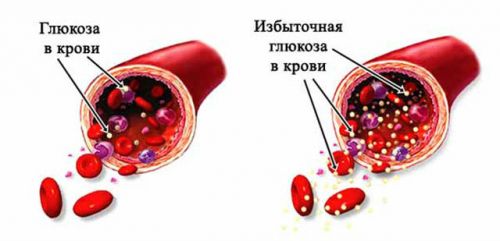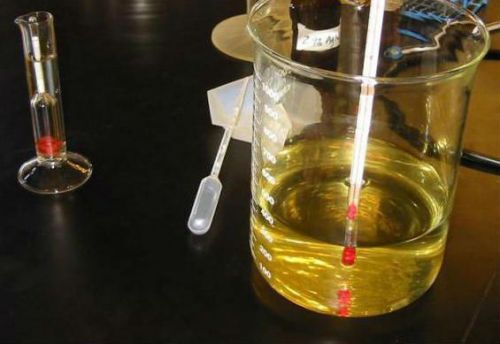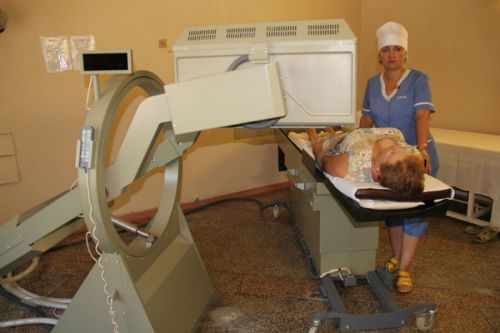Gipermenorea called as increasing the density of urine more than 1030 g/l. the relative density is determined by the concentration of dissolved substances in urine the. It is known that the urine excreted by the kidneys more than 150 chemical compounds.
Some of them the accumulation in the blood is a danger to the body. Others involved in supporting of osmotic balance of blood acid-base balance, so the excess is discharged into the urine.
The most frequently gipermenorea accompanied by a reduction in the production of urine when the kidney produces less than 500 ml per day (oligo – and anuria). But to identify these violations impossible.
From chemistry we know that to increase the concentration of the solution in two ways:
- the water reduction at constant dry residue;
- the increase in the solution substances with high specific weight.
The third option – mixed. In vivo these processes are regulated, and only pathology can cause disruptions.

When there is a loss of water?
The decrease of the volume of the liquid portion of urine is possibly as a reflex reaction to her loss:
- sweating in the heat, or a febrile condition;
- massive blood loss;
- toxicosis in pregnant women;
- the plasma loss at common burns of the skin;
- prolonged vomiting or diarrhea;
- a sharp decrease in fluid intake.
The pathological mechanism of increased reabsorption of water is associated with impaired excretion of sodium in the renal tubules. Sodium retention leads to the simultaneous termination of the output is coupled with water molecules.
With the development of heart failure the amount of urine decreases as the liquid passes to the swelling.
In this case the value of the following mechanisms:
- exceeding the level of venous pressure on arterial knee of the capillaries;
- increased permeability of the vascular wall.
- the resulting spasm of the arteries of the glomeruli in response to ischemia of the body and oxygen deprivation;
- enhanced activation of antidiuretic hormone and aldosterone adrenal glands.
What pollutants affect gipermenorea?
Of filtered through the basement membrane substances of greatest weight have protein, glucose, urea. It is established that loss each 3 g of protein per litre of urine increase the density per unit, and the transition in urine 10 g of glucose raises the growth rate by 4. How do these substances appear in the urine?
Protein molecules do not fall in a healthy person in the primary urine. The reason is their too great size. Cracks in the membrane is insufficient for the passage of proteins. The presence in the urine protein is an indicator of destruction of nephrons of the kidney.

Electron microscopy demonstrates increases in different passing through the membrane are molecules of proteins
This process takes place:
- in infectious and autoimmune glomerulonephritis;
- interstitial nephritis due to compression and ischemia of the glomeruli inflamed interstitial tissue;
- in the advanced stage of pyelonephritis, when the inflammation and swelling that goes with the Cup-renal pelvis space on the cortical layer;
- amyloidosis of the kidneys with the blockade of amyloid substance filtration operation of the membrane.
Glucose – the energy source of calorie, a very important substance for the body. Why it’s removed?
The renal mechanism is the exceeding of the threshold of saturation of the cells of the tubular epithelium. It is established that normal with average blood glucose for children 7 µmol/l for adults 8.9–10, the kidneys stop selling absorption of glucose and excrete it into the urine.
With the defeat of the tubular device threshold concentrations do not matter. Even with a lower sugar content in blood it is excreted in the urine. Sign of renal glycosuria is a normal rate of glucose in the blood. The role of endocrine regulation is in violation of assimilation by the tissues (loss of sensitivity to insulin) of glucose in connection with the failure of hormonal effects.

This is called extrarenal glucosuria and always occurs on a background of high hyperglycemia (high blood sugar)
Among the urea nitrogenous substances takes the leading place, accounting for 75% of the total residual nitrogen. It is found in the blood and urine. The growth of concentration in the urine occurs in parallel.
Matter:
- increased protein breakdown (trauma, postoperative);
- febrile period of infectious diseases;
- overdose of Aspirin, Quinine;
- application in the treatment of corticosteroids;
- atrophic processes in tissues and muscles;
- some types of poisoning;
- inflammatory diseases of the urinary organs (especially pyelonephritis, nephritis);
- hepatitis and cirrhosis of the liver;
- diabetes mellitus;
- beriberi.
Features increased gipermenoree in children
In children the kidneys reach their full functioning in 2-3 years. Up to this time to judge the density of urine status gipermenoree necessary according to their standards and exceeding their upper limit.
| The age of the child | The upper limit of the normal relative density in g/l |
| newborn | 1018 |
| 6 months | 1004 |
| 12 months | 1010 |
| 2 years | 1017 |
| from 3 to 5 years | 1020 |
| in 7-8 years | 1022 |
| 12 years | 1025 |
The main diseases associated with gipermenorea
Gipermenorea detected at the time of supervision of patients with the following diseases:
- diabetes mellitus;
- in severe nephrotic syndrome in case of glomerulonephritis, interstitial nephritis;
- toxemia complicating pregnancy;
- cardiac decompensation with progressive swelling;
- lesions of the stomach and intestines, with frequent vomiting and diarrhea;
- in a state of shock;
- under oligo-anuria chronic renal failure;
- infectious diseases with high fever;
- the syndrome of dehydration (blood and plasma loss, exercise in the heat, the prolonged absence of drinking water).
Doctors know the same change in the density of urine when treating patients with antibiotics, corticosteroids, on the second day after pyelography.
How does gipermenorea?
The change in the density of urine does not have specific signs. The increase noted in the measurement of different laboratory techniques or conventional prometra.
However, diseases that are accompanied by gipermenorea may be accompanied by its typical symptoms:
- pain syndrome (different from the intensity and nature of pain in the abdomen, above the pubis);
- nausea, vomiting;
- frequent liquid stools;
- thirst;
- itching;
- swelling of the face, legs, ascites (enlargement of abdomen due to accumulation of fluid);
- dysuric syndrome;
- weight loss;
- increase in blood pressure, convulsions;
- shock to faint, pressure drop;
- dryness of the tongue and mucous membranes, ulcers in the mouth;
- yellowness of the skin and sclera.
How to prove the pathology laboratory?
People can assume for themselves hyperstereo at low urine output, its intense orange-brown color. Most frequently to obtain reliable data used a technique of General. The patient is asked to urinate at 6 a.m. and continue to collect urine at intervals of 3 hours during the day. Each of the eight tanks are required to sign (to put time). Additionally calculated the total daily urine output, takes into account the amount of fluid you drink.

Measurement of relative density at the sample of the General gives eight indicators
About gipermenoree judged by exceeding norm in most samples.
What laboratory values help in finding the reason?
Given the list of diseases opens wide possibilities for diagnostics.
The patient should check out:
- urinalysis and blood;
- blood sugar, protein fractions and total protein;
- liver function tests, bilirubin;
- residual nitrogen, creatinine, urea of blood;
- sugar urine;
- biochemical composition of urine (protein, urea, glucose).
Patients with persistent gipermenorea have to consult with my endocrinologist, urologist, nephrologist.
You may need:
- to donate blood to a more specific reaction, by definition, hormones, electrolyte composition;
- to check up on ultrasound of the kidneys and liver;
- to estimate the glomerular filtration rate;
- to carry out angiography of the kidneys;
- ECG to examine the assumption of cardiac decompensation.
To such grounds as gipermenorea should not be taken lightly. He can point to hidden disease, initial stage. It is therefore necessary to identify the exact cause and on the recommendation of the doctor to change the diet, fluid intake, conduct prophylactic treatment.



